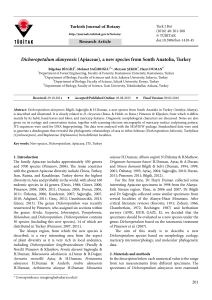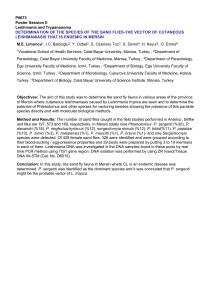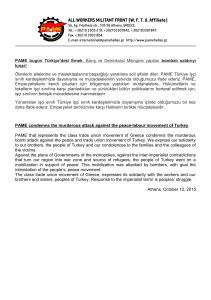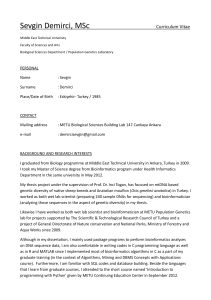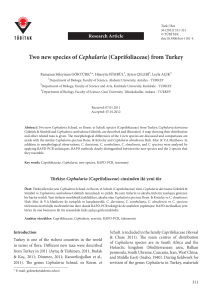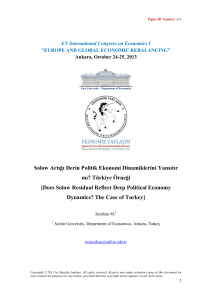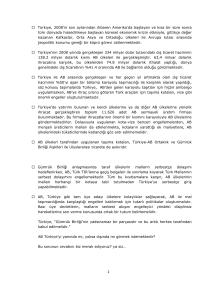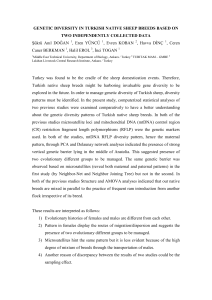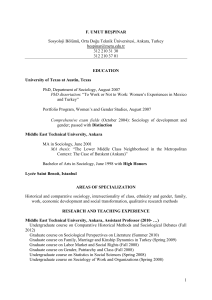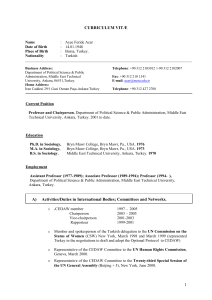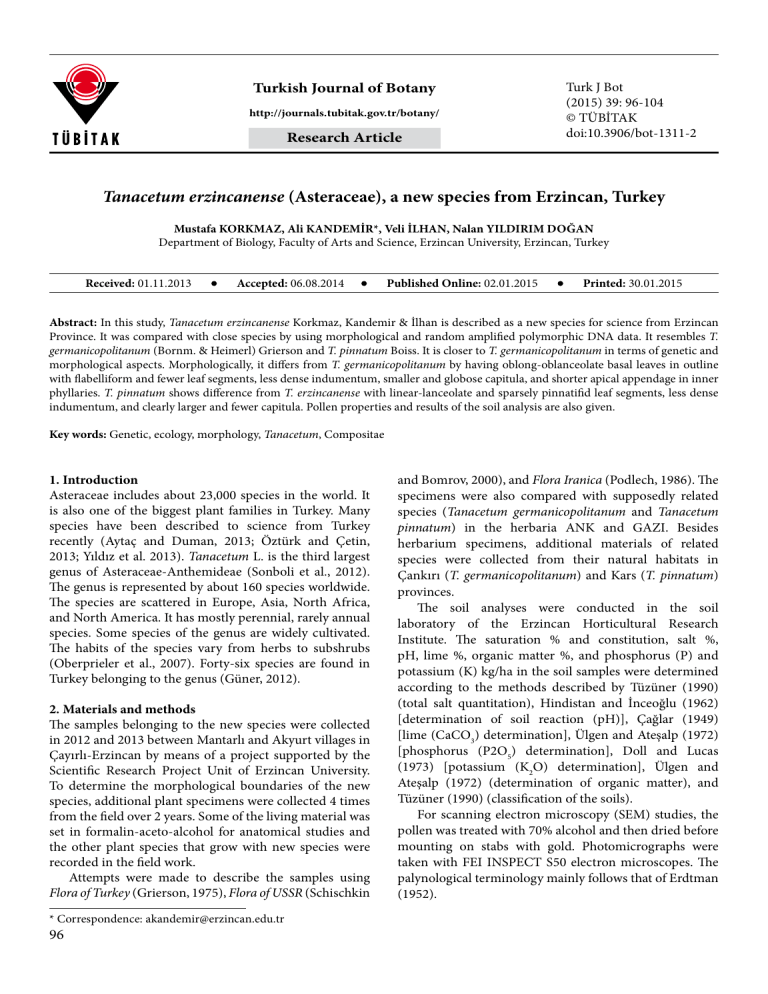
Turkish Journal of Botany
http://journals.tubitak.gov.tr/botany/
Research Article
Turk J Bot
(2015) 39: 96-104
© TÜBİTAK
doi:10.3906/bot-1311-2
Tanacetum erzincanense (Asteraceae), a new species from Erzincan, Turkey
Mustafa KORKMAZ, Ali KANDEMİR*, Veli İLHAN, Nalan YILDIRIM DOĞAN
Department of Biology, Faculty of Arts and Science, Erzincan University, Erzincan, Turkey
Received: 01.11.2013
Accepted: 06.08.2014
Published Online: 02.01.2015
Printed: 30.01.2015
Abstract: In this study, Tanacetum erzincanense Korkmaz, Kandemir & İlhan is described as a new species for science from Erzincan
Province. It was compared with close species by using morphological and random amplified polymorphic DNA data. It resembles T.
germanicopolitanum (Bornm. & Heimerl) Grierson and T. pinnatum Boiss. It is closer to T. germanicopolitanum in terms of genetic and
morphological aspects. Morphologically, it differs from T. germanicopolitanum by having oblong-oblanceolate basal leaves in outline
with flabelliform and fewer leaf segments, less dense indumentum, smaller and globose capitula, and shorter apical appendage in inner
phyllaries. T. pinnatum shows difference from T. erzincanense with linear-lanceolate and sparsely pinnatifid leaf segments, less dense
indumentum, and clearly larger and fewer capitula. Pollen properties and results of the soil analysis are also given.
Key words: Genetic, ecology, morphology, Tanacetum, Compositae
1. Introduction
Asteraceae includes about 23,000 species in the world. It
is also one of the biggest plant families in Turkey. Many
species have been described to science from Turkey
recently (Aytaç and Duman, 2013; Öztürk and Çetin,
2013; Yıldız et al. 2013). Tanacetum L. is the third largest
genus of Asteraceae-Anthemideae (Sonboli et al., 2012).
The genus is represented by about 160 species worldwide.
The species are scattered in Europe, Asia, North Africa,
and North America. It has mostly perennial, rarely annual
species. Some species of the genus are widely cultivated.
The habits of the species vary from herbs to subshrubs
(Oberprieler et al., 2007). Forty-six species are found in
Turkey belonging to the genus (Güner, 2012).
2. Materials and methods
The samples belonging to the new species were collected
in 2012 and 2013 between Mantarlı and Akyurt villages in
Çayırlı-Erzincan by means of a project supported by the
Scientific Research Project Unit of Erzincan University.
To determine the morphological boundaries of the new
species, additional plant specimens were collected 4 times
from the field over 2 years. Some of the living material was
set in formalin-aceto-alcohol for anatomical studies and
the other plant species that grow with new species were
recorded in the field work.
Attempts were made to describe the samples using
Flora of Turkey (Grierson, 1975), Flora of USSR (Schischkin
*Correspondence: [email protected]
96
and Bomrov, 2000), and Flora Iranica (Podlech, 1986). The
specimens were also compared with supposedly related
species (Tanacetum germanicopolitanum and Tanacetum
pinnatum) in the herbaria ANK and GAZI. Besides
herbarium specimens, additional materials of related
species were collected from their natural habitats in
Çankırı (T. germanicopolitanum) and Kars (T. pinnatum)
provinces.
The soil analyses were conducted in the soil
laboratory of the Erzincan Horticultural Research
Institute. The saturation % and constitution, salt %,
pH, lime %, organic matter %, and phosphorus (P) and
potassium (K) kg/ha in the soil samples were determined
according to the methods described by Tüzüner (1990)
(total salt quantitation), Hindistan and İnceoğlu (1962)
[determination of soil reaction (pH)], Çağlar (1949)
[lime (CaCO3) determination], Ülgen and Ateşalp (1972)
[phosphorus (P2O5) determination], Doll and Lucas
(1973) [potassium (K2O) determination], Ülgen and
Ateşalp (1972) (determination of organic matter), and
Tüzüner (1990) (classification of the soils).
For scanning electron microscopy (SEM) studies, the
pollen was treated with 70% alcohol and then dried before
mounting on stabs with gold. Photomicrographs were
taken with FEI INSPECT S50 electron microscopes. The
palynological terminology mainly follows that of Erdtman
(1952).
KORKMAZ et al. / Turk J Bot
Genomic DNA was extracted from powdered
leaf materials using the QIAGEN DNA extraction kit
(QIAGEN, Germany) according to the manufacturer’s
instructions. The purity and quantity of genomic DNA was
determined spectrophotometrically and confirmed using
0.8% agarose gel electrophoresis. Nine primers were used
to generate random amplified polymorphic DNA (RAPD)
profiles. PCR amplification reactions were carried out
in 30 µL (final volume) of reaction mixture containing:
10X buffer at 3.0 µL, dNTPs (10 mM) 1.2 µL, magnesium
chloride (25 mM) 1.2 µL, primer (5 µM) 2.0 µL, Taq
polymerase (5 units) 0.4 µL, water 19.2 µL, and sample
DNA 3.0 µL (100 ng/µL). The thermal cycler (Eppendorf
Company, Germany) was programmed for 2 min at 95 °C;
2 cycles of 30 s at 95 °C, 1 min at 37 °C, and 2 min at 72 °C;
2 cycles of 30 s at 95 °C, 1 min at 35 °C, and 2 min at 72
°C; 41 cycles of 30 s at 94 °C, 1 min at 35 °C, and 2 min at
72 °C; and a final 5-min extension at 72 °C, then brought
down to 4 °C.
The PCR products (27 µL) were mixed with 6X gel
loading buffer (3 µL) and loaded onto agarose (1.5% w/v)
gel electrophoresis in 0.5X TBE (Tris-Borate-EDTA)
buffer at 70 V for 150 min. The gel was stained in ethidium
bromide solution (2 µL EtBr/100 mL 1X TBE buffer) for
40 min and visualized under UV light in the Bio Doc
Image Analysis System with the UVIsoft analysis package
(UVIsoft, UK).
PCR products were scored as the presence (1) or
absence (0) of band for each genotype and analyzed. Data
were used to calculate a Jaccard (1908) similarity index,
from which a UPGMA dendrogram was constructed. All
of the experiments in this study were repeated twice.
3. Results and discussion
Tanacetum erzincanense Korkmaz, Kandemir & Ilhan sp.
nov. (Figure 1)
Type: B7 Erzincan, Çayırlı, between Mantarlı and
Akyurt villages, 39°43′709″N, 40°10′118″E, 1622 m,
02.07.2012, steppe, M. Korkmaz & V. İlhan 3249 (holotype:
GAZI, isotypes: NGBB, ANK).
Diagnosis: The new species is related to T.
germanicopolitanum (local endemic to Çankırı) and T.
pinnatum. Not only were herbarium materials of the
related species examined, but additional specimens were
also collected from their natural habitats during the study.
Description: Perennial with woody rhizomes. Stems
erect, rarely ascending, 18–34 cm high, angular to terete
with ridges, 2–3.5 mm in diam., grayish, tomentose to
subglabrous, corymbosely branched above. Basal leaves
2–10 cm (incl. petiole), oblong to oblanceolate in outline,
densely grayish generally in young leaves to sparsely
tomentose, grayish to greenish color in old leaves with 2–5
pairs of lateral segments, rarely only 1 terminal leaflet in
young leaves of basal leaves; lateral segments 7–13 × 7–9
mm, flabelliform, ovate to obovate or orbicular in outline,
cuneate, rarely rounded in young basal leaves, apically
3–7 rounded to acute lobes or pinnatifid, sometimes the
lowest segments almost entire in young leaves, ultimate
segment larger than lateral one, tripartite, separation more
than half of segment, sometimes near to base, trilobed,
each lobe (2)–3–5-toothed; cauline leaves similar to basal
leaves, decreasing in size and pairs of lobes, upper ones
sessile, the lowest pair usually entire; the uppermost
leaves near capitula with a few segments or reduced to
entire bracts. Capitula 12–110 per stem. Involucre 3–4
× 2.5–3.5 mm; phyllaries 3 series, 2.5–3 × 1.5–2 mm
long, white tomentose; outer one linear lanceolate with
narrow scarious margin and shorter than inner one; inner
phyllaries oblong with distinct and ±lacerate scarious
whitish to brownish c. 0.5-mm-long appendages, longer
than outer one. Ray flowers somewhat longer than disk
flowers, 6–8; ligule with 2–3 teeth, 2–2.5 mm, elliptic to
rotund; style arms divergent (sometimes turned down),
achenes whitish to brownish, ±curved, tuberculate. Disk
flowers c. 2 mm, yellow; tube verrucose; anthers exerted,
whitish; style bifid, divergent, whitish in young flowers,
brownish in old ones; achenes as long as tube, median
ones ±straight, outer one slightly curved. Fl. June–July in
steppe.
Determined pollen properties are indicated as
monad. Shape: spheroidal; outline in polar view: circular;
ornamentation: echinate-perforate; aperture number: 3;
aperture type: colporate (Figure 2).
Examined specimens. Tanacetum germanicopolitanum:
B7 Erzincan, Çayırlı, between Mantarlı and Akyurt villages,
39°43′709″N, 40°10′118″E, 1622 m, 23.06.2013, steppe,
M. Korkmaz & V. İlhan 3673 (paratypes: GAZI, NGBB,
ANK). Tanacetum germanicopolitanum: A4 Çankırı: from
Çankırı to Kastamonu, Hıdırlık Tepe, around reservoir,
36T0549600E, 4495439N, 959 m, 05.06.2013, T. Körüklü
1-56-2013 (4 sheets) (ANK); Paphlagonia.: Ad appidum
Cankiri in vinetis derelicts vallis Cakmakli-dere c. 800 m,
16.06.1929, Bornm. 14254! (E, K); Cankiri (Paplagonien)
Stappenhügel auf Kalk Westlich ob der Stadt. 850 m, 20
Juni 1955, Hub.-Morath 1300! (E); A4 Çankırı. Çankırı’nın
batısı, Devrendi Deresi 850 m, 23.06.1976, N. Çelik 190!
(ANK); A4 Ankara-Çankırı Yolu, 81. km, 800–840 m,
05.07.1995, andezit step, Z. Aytaç & H. Duman 5777!
(GAZI). Tanacetum germanicopolitanum: B8: Kars,
Kağızman, Kandemir 10347 (NGBB); between Erzurum
and Tamrut (at present known as Şendurak village, Oltu,
Erzurum), 18.06.1976, 1300–1500 m, N. Çelik 189! (ANK).
The locations of the examined specimens are indicated in
Figure 3.
97
KORKMAZ et al. / Turk J Bot
Figure 1. General habit of Tanacetum erzincanense.
Tanacetum erzincanense can be distinguished from
Tanacetum germanicopolitanum by its oblong-oblanceolate
basal leaves in outline with 3-5 paired lateral segments
(not narrowly linear-oblanceolate with 7–11 paired), leaf
segments with flabelliform, ovate to obovate or orbicular
in outline, usually equal to its width (not flabelliform or
oblong to oblanceolate, usually longer than its width) 3–4
× 2.5–3.5 mm involucre (not 6–8 × 4–5 mm), various
appendages c. 0.5 mm long in inner phyllaries (not c. 1
mm long), and 6–8 ray flowers (not 5) (Table 1).
98
T. pinnatum is recorded from Erzurum-Oltu, Kars,
Kağızman, and Van-Erciş, and it also grows in Iraq, Iran,
and the Caucasus. Some characters of the phyllaries
and flowers of T. erzincanense are similar to those of T.
pinnatum. However, T. pinnatum is quite different with
its leaves with narrow, linear leaf segments and fewer and
larger capitula. The number of capitula is at most 25 per
stem in T. pinnatum. General habits of T. erzincanense and
related species are indicated in Figure 4, and capitula and
basal leaves are shown in Figure 5.
KORKMAZ et al. / Turk J Bot
Figure 2. Pollen morphology of Tanacetum erzincanense.
Figure 3. The distribution of Tanacetum erzincanense (■), Tanacetum germanicopolitanum (▲), and Tanacetum
pinnatum (○).
According to ITS and trnH-psbA data, Tanacetum
germanicopolitanum is close to T. pinnatum Boiss. (Sonboli
et al., 2012). PCR-based RAPD was used to identify genetic
variations between plant species since its application does
not need any prior information about target sequence
on the genome (Khanuja et al., 1998). RAPD markers
were successfully used to study genetic diversity in plant
species such as those from Vanilla Mill. (Besse et al.,
2004), Diospyros L. (Akbulut et al., 2008), Oleaceae (Zheng
et al., 2009), Thymus L. (Sunar et al., 2009), and Allium
L. (Mukherjee et al., 2013). Thus, the new species was
compared with T. germanicopolitanum and T. pinnatum
Boiss. by using RAPD markers.
Results of RAPD analysis are summarized in Table
2. Nine of the 34 initial primers produced clear and
reproducible polymorphic bands among the 3 Tanacetum
species. Those 9 random primers generated a total of 62
RAPD bands (Figure 6). The size of the amplicons ranged
from 250 to 2700 bp. Primer OPB-03 gave the highest
number of RAPD products (10). Primers OPY-7 and
OPY-13 gave the lowest number of RAPD products (5)
(Table 2). In total, 92.1% of the bands were polymorphic.
99
KORKMAZ et al. / Turk J Bot
Figure 4. General habits of Tanacetum erzincanense (A), T. germanicopolitanum
(B), and Tanacetum pinnatum (C).
The dendrogram realized from the RAPD markers
grouped the 3 genotypes into 2 major clusters (Figure
7). Cluster 1 consists of T. pinnatum. Cluster 2 consists
of T. erzincanense and T. germanicopolitanum. The
greatest similarity was observed between T. erzincanense
and T. germanicopolitanum (0.124), while the greatest
100
dissimilarity was observed between T. pinnatum and T.
germanicopolitanum (0.963).
Tanacetum erzincanense grows on the steppe of the
Çayırlı district (Erzincan Province) at an altitude of 1622
m. Vegetation of the area is formed by herbaceous plant
species including
KORKMAZ et al. / Turk J Bot
Figure 5. Capitula and basal leaves: Tanacetum erzincanense: A- capitula, D- basal leaves.
Tanacetum germanicopolitanum: B- capitula, E- basal leaves. Tanacetum pinnatum:
C- capitula, F- basal leaves.
Achillea millefolium L. subsp. millefolium L., Bellevalia
gracilis Feinbrun, Bupleurum rotundifolium L., Centaurea
polypodiifolia Boiss., Dorycnium pentaphyllum Scop. subsp.
anatolicum (Boiss.) Gams, Euphorbia virgata Waldst. &
Kit., Hedysarum nitidum Willd., Medicago × varia Martyn,
Nigella latisecta P.H.Davis, Onobrychis armena Boiss. &
Huet, Onobrychis stenostachya Freyn subsp. krausei (Sirj.)
Hedge, Ononis spinosa L., Pisum sativum L. subsp. sativum
var. arvense (L.) Poiret, Teucrium polium L., and Ziziphora
tenuior L.
101
KORKMAZ et al. / Turk J Bot
Table 1. Diagnostic characters of Tanacetum erzincanense and Tanacetum germanicopolitanum.
Characters
T. erzincanense
T. germanicopolitanum
T. pinnatum
Lower leaves
Oblong-oblanceolate in outline
with 3–5 paired lateral segments.
Lateral segments flabelliform, ovate
to obovate or orbicular in outline
and usually equal to its width.
Narrowly linear-oblanceolate in
outline with 7–11 paired lateral
segments. Segments oblong to
oblanceolate and usually longer
than its width.
Oblanceolate in outline with 4–6
paired lateral segments. Lateral
segments linear lanceolate and
clearly longer than its width.
Capitula
(12–)30–110 per stem
10–40 per stem
4–25 per stem
Involucre
3–4 × 2.5–3.5 mm
6–8 × 4–5 mm
6–7 × 5–6 mm
Phyllaries
3 series, appendages c. 0.5 mm in
inner one
3–4 series, appendages c. 1 mm in
inner one
3 series, appendages c. 1 mm in
inner one
Habitat
Steppe
Chalky hill-steppe
Stony slopes, rock crevices
Indumentum
of leaves
Sparsely and leaf surface visible
Dense and leaf surface invisible
Densely and leaf surface ±visible
Table 2. Total number of amplified fragments and number of polymorphic fragments generated by polymerase chain reaction using
selected random decamers.
Primer
Sequence (5’–3’)
Length of
amplified bands
No. of
bands
No. of polymorphic
bands
Polymorphism
rate (%)
A-1
AGTCAGCCAC
750–1800
6
5
83.3
C-10
TGTCTGGGTC
300–2000
9
8
88.88
OPA- 4
AATCGGGCTG
500–2300
8
8
100
OPB- 03
CATCCCCCTG
400–2500
10
10
100
OPH- 16
TCTCAGCTGG
250–2200
8
7
87.5
OPY- 7
AGAGCCGTCA
750–2000
5
5
100
OPY-13
GGGTCTCGGT
500–1800
5
4
80
OPW– 8
GACTGCCTCT
750–2700
7
6
85.7
OPY- 19
TGAGGGTCCC
300–1600
5
5
100
250–2700
63
58
92.1
Total
According to the results of soil analysis for the new
species, saturation value was 75.00. Soil pH was 7.59.
Electrical conductivity was 0.0007 S and organic matter
was 2.32%. Lime (CaCO3) was 38.80%. Salt concentration
was 0.034%, phosphorus was 1.282 kg/ha, and potassium
concentration was 18.37 kg/ha. The results of the soil
analysis demonstrated that the soil properties of the new
species are as follows: rough texture, slightly alkaline,
medium amount of organic matter, high amount of lime,
saltless, low phosphorus content, and moderate potassium
content.
102
According to the results of soil analysis for T.
germanicopolitanum, saturation value was 50.00. Soil
pH was 7.59. Electrical conductivity was 0.00043 S;
organic matter was 1.74%. Lime (CaCO3) was 34.10%.
Salt concentration was 0.014%, phosphorus was 4.81 kg/
ha, and potassium concentration was 35.10 kg/ha. The
results of the soil analysis indicate that the soil properties
of T. germanicopolitanum are rough texture, slightly
alkaline, low amount of organic matter, slightly salty, low
phosphorus content, and moderate potassium content.
KORKMAZ et al. / Turk J Bot
0
Num
5
10
15
20
25
Figure 6. Results of gel electrophoresis of PCR products obtained.
Figure 7. UPGMA dendrogram showing the relationship of 3
Tanacetum species.
Tanacetum erzincanense is an endemic species and the
IUCN category was determined by considering World
Conservation Union categories (IUCN Species Survival
Commission, 2014). According to the field observations
during 3 years, the area of occupancy is estimated to
be less than 10 km2 and the species is known from only
1 population. The population is very near to the villages
and under the threat of excessive animal husbandry. As a
result, the IUCN category of the new species was evaluated
as “Critically Endangered”, (CR)B2ab (i,ii).
Acknowledgments
The specimens were collected during a project supported
by the Scientific Research Project Unit of Erzincan
University (Project No.: EUBAP 2011-10.01.05). We
would like to thank the Unit for its financial support. Some
T. germanicopolitanum specimens were collected from
Çankırı by Tuğrul Körüklü from ANK. Research Assistant
Selim Çöğenli from Atatürk Üniversity helped with the
SEM studies. We also thank them.
References
Akbulut M, Ercisli S, Yıldırım N, Orhan E, Agar G (2008). The
comparison of persimmon genotypes (Diospyros kaki Thunb.)
by using RAPD and FAME data. Roum Biotechnol Lett 13:
3851–3858.
Aytaç Z, Duman H (2013). A new species and 2 new records from
Turkey. Turk J Bot 37: 1055–1060.
Besse P, Silva DD, Bory S, Grisoni M, Bellec FE, Duval MF (2004).
RAPD genetic diversity in cultivated vanilla: Vanilla planifolia,
and relationships with V. tahitensis and V. pompona. Plant Sci
167: 379–385.
Çağlar KÖ (1949). Toprak Bilgisi. Ankara, Turkey: Ankara
Üniversitesi Ziraat Fakültesi Yayınları (No.: 10) (in Turkish).
Doll EC, Lucas RE (1973). Testing soils for potassium, calcium and
magnesium. In: Westerman RI, editor. Soil Testing and Plant
Analysis. Madison, WI, USA: Soil Science Society of America,
pp. 181–227.
Erdtman G (1952). Pollen Morphology and Plant Taxonomy.
Uppsala, Sweden: Almqvist & Wiksell.
Grierson AJC (1975). Tanacetum L. In: Davis PH, editor. Flora of
Turkey and the East Aegean Islands, Vol. 5. Edinburgh, UK:
Edinburgh University Press, pp. 256–292.
103
KORKMAZ et al. / Turk J Bot
Güner A (2012). Türkiye Bitkileri Listesi. İstanbul, Turkey: Ali Nihat
Gökyiğit Vakfı Yayınları (in Turkish).
Hindistan M, İnceoğlu İ (1962). Toprakta pH tayini. Ankara, Turkey:
Tarım Bakanlığı, Topraksu Genel Müdürlüğü, Toprak ve Gübre
Araştırma Enstitüsü (in Turkish).
IUCN Species Survival Commission (2014). Guidelines for Using
the IUCN Red List Categories and Criteria. Version 11. Gland,
Switzerland: IUCN.
Jaccard P (1908). Nouvelles recherches sur la distribution florale. Bul
Soc Vaudoise Sci Nat 44: 223–270 (in French).
Khanuja SPS, Shasany AK, Daroker MP, Kumar S (1998). DNA
fingerprinting of plant genetic resources: the need of time. J
Med Arom Pl Sci 20: 348–351.
Mukherjee A, Sikdar B, Ghosh B, Banerjee A, Ghosh E, Bhattacharya
M, Roy SC (2013). RAPD and ISSR analysis of some
economically important species, varieties, and cultivars of the
genus Allium (Alliaceae). Turk J Bot 37: 605–618.
Oberprieler CH, Vogt R, Watson LE (2007). Tribe Anthemideae Cass.
In: Kadereit JW, Jeffrey C, editors. The Families and Genera of
Vascular Plants, Vol. 8: Flowering Plants, Eudicots, Asterales.
Heidelberg, Germany: Springer-Verlag, pp. 342–374.
Öztürk M, Çetin Ö (2013). Inula tuzgoluensis (Asteraceae), a new
species from Central Anatolia, Turkey. Turk J Bot 37: 825–835.
Podlech D (1986). Tanacetum L. In: Rechinger KH, editor. Flora
des Iranischen Hochlandes und der Umrahmenden Gebirge,
Persien, Afghanistan, Teile Von West-Pakistan, Nord-Iraq,
Azerbaidan, Turkmenistan. Graz, Austria: Balogh Scientific
Books, pp. 88–148 (in German).
104
Schischkin BK, Bobrov EG (2000). Compositae. In: Flora of the
USSR, Vol. XXVI. Washington, DC, USA: Smithsonian
Institute Libraries.
Sonboli A, Stroka K, Osaloo SK, Oberprieler C (2012). Molecular
phylogeny and taxonomy of Tanacetum L. (Compositae,
Anthemideae) inferred from nrDNA ITS and cpDNA trnH–
psbA sequence variation. Plant Syst Evol 298: 431–444.
Sunar S, Aksakal O, Yildirim N, Agar G, Gulluce M, Sahin F (2009)
Genetic diversity and relationships detected by FAME and
RAPD analysis among Thymus species growing in eastern
Anatolia region of Turkey. Roum Biotechnol Lett 14: 4313–
4318.
Tüzüner A (1990). Toprak ve Su Analiz Lab. El Kitabı. Ankara,
Turkey: Tarım Orman ve Köyişleri Bakanlığı Köy Hizmetleri
Genel Müdürlüğü (in Turkish).
Ülgen N, Ateşalp M (1972). Toprakta Bitki Tarafından Alınabilir
Fosfor Tayini. Ankara, Turkey: Köy İşleri Bakanlığı, Topraksu
Genel Müdürlüğü, Toprak ve Gübre Araştırma Enstitüsü
Yayınları 21 (in Turkish).
Yıldız B, Arabacı T, Dirmenci T (2013). Two new species of Cirsium
(Asteraceae) and notes on allies from Turkey. Turk J Bot 37:
1045–1054.
Zheng DJ, Liang YF, Liu GM, Yan DH, Linghu CD, Tian YH (2009).
RAPD analysis of germplasm resources of Kudingcha species
in Oleaceae. Agric Sci China 8: 784–792.

